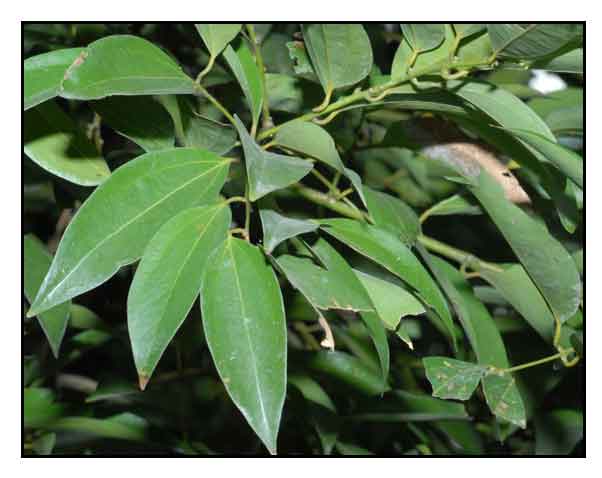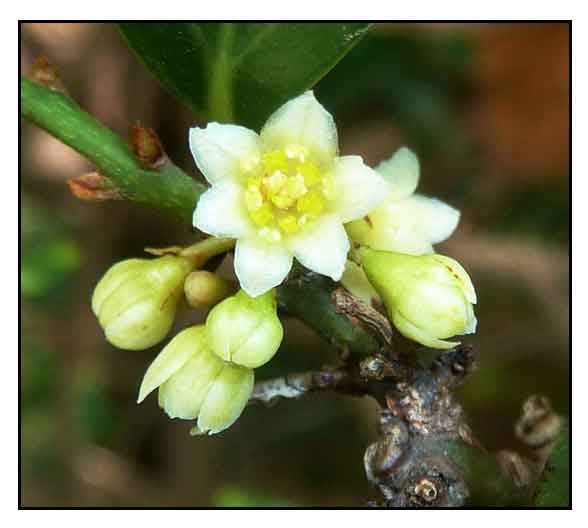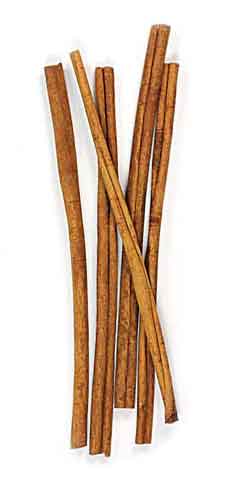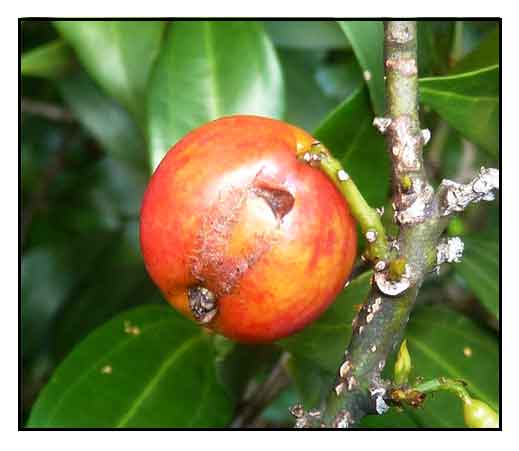 Gen info Gen info
- Cinnamon is one of the oldest spices.
- Records of Chinese herbalists noted the Cassia bark has been used as far back as 2700 BC. Cassia cinnamon was brought to Egypt around 500 BC where it was valued as an additive to embalming mixtures. The Greeks, Romans, and ancient Hebrews were the first to use it as a cooking spice.
(23)
- The four main economically important species of cinnamon in the genus Cinnamomum are:
(1) Cinnamomum verum, C. zeylanicum, "true cinnamon," also called Sri Lankan or Ceylon cinnamon.
(2) Cinnamomum cassia, (C. aromaticum), Chinese cinnamon; (3) Cinnamomum burmannii, also called Korintje, Java, or Indonesian cinnamon, and (4) Cinnamomum louireiroi, Vietnamese or Saigon cinnamon.
(3)
Botany
Kami is a medium-sized evergreen tree, growing 7 to 10 meters in height, with an aromatic bark and smooth, angular branches. Leaves are opposite or sub-opposite, smooth, leathery, oblong with the smaller ones sometimes lanceolate, 7 to 15 centimeters long, 3 centimeters wide, pointed at both ends, on petioles less than 1 centimeter long. Inflorescence is about 15 centimeters long, bearing 1 to 2 small, greenish flowers at its end, about 5 millimeters long. Fruit is obovately ellipsoid, about 1.25 centimeters long and 7.5 millimeters wide, lucid green with minute whitish spots when unripe and a shinning steel blue when ripe.
Distribution
- In the Philippines, only in Surigao, Davao, and Zamboanga Provinces in Mindanao.
- In thickets and forests at low and medium altitudes.
 Constituents Constituents
- Study has suggested the bark to be closely allied to Cinnamomum zeylanicum, and the bark, in appearance, taste and odor, is just like the cinnamon of commerce.
- The oil does not agree very closely with Ceylon cinnamon oil from Cinnamomum zeylanicum.
-
Bark contains 60% cinnamic aldehyde.
- Constituent studies on C. burmannii have yielded cinnamyl alcohol, coumarin, cinnamic acid, cinnamaldehyde, anthocyanin, and essential oils, together with sugar, protein, crude fates, and pectin among others.
(3)
- GC-MS and LC-MS studies of bark extract
identified major compounds viz., a predominant volatile oil component ((E)-cinnamaldehyde) and several polyphenols (mainly proanthocyanidins and (epi)catechins). (see study below) (6)
 - Study isolated a pigment from the peel of C. burmannii, scarcely soluble in water and all common organic solvents, and soluble only in alkaline aqueous and DMSO. (7) - Study isolated a pigment from the peel of C. burmannii, scarcely soluble in water and all common organic solvents, and soluble only in alkaline aqueous and DMSO. (7)
- GC-MS analysis of stem bark for trans-cinnamaldehyde in 50% aqueous methanol and water extracts were 50.14 µg/mg and 12.83 µg/mg of dry extract, respectively. (see study below) (20)
- Nutrient analysis (1 cup/125 g) yielded: (Basic components) ash 4.5g, phytosterols 32mg, protein 5g, water 13.3g; (Calories) total 308, from carbohydrates 287, from fat 13, from protein 9.1; (Carbohydrates) dietary fiber 66g, sugar 2.7g, total carbohydrates 101g; (Fats & Fatty Acids) monosaturated fat 307mg, omega-5 fatty acids 14mg, omega-6 fatty acids 55mg, polyunsaturated fat 85mg, saturated fat 431mg, total fat 1.5g; (Vitamins) betaine 4.9mg, choline 13.8mg, folate 7.5mcg, niacin 1.7mg, pantothenic acid 447mcg, riboflavin 51mcg, thiamin 27mcg, vitamin A 368 IU, vitamin B6 197 mcg, vitamin C 4.7 mg, vitamin E 2.9 mg, vitamin K 39 mcg; (Minerals) calcium 1.3g, copper 423mcg, iron 10mg, magnesium 75mg, manganese 22mg, phosphorus 80mg, potassium 538mg, selenium 3.9mcg, sodium 12mg, zinc 2.3mg. (21)
- GC-MS analysis of essential oil yielded the active compound cinnamaldehyde (71.814%), trans-cinnamyl acetate (11.09%), coumarin (3.41%), and cineol (1.77%). (see study below)
(24)
- Study of essential oil yielded major components of cinnamaldehyde (68.3-82%), cinnamyl acetate (2.5-16%), cinnamyl alcohol (2.25-4.6%), and cinnamic acid (3-8%). (see study below) (27)
- Study of stems yielded a novel amide, cinnabutamine (1), along with five known amides, cinnaretamine (2), N-trans-caffeoyl-5-hydroxytyramine (3), N-trans- feruloyltyramine (4), N-trans-feruloyl-5-methoxytyramine (5) and N-cis-feruloyl-5-methoxytyramine (6), (31)
Properties
- The characteristic flavor and aroma of cinnamon comes for its aromatic essential oils; the higher the level, the stronger the flavor. C. burmannii, although high in cinnamaldehyde, has a smoother taste with less bite than C. cassia and C. loureiroi. C. verum, C. cassia, and C. loureiroi cinnamons have strong, spicy-sweet flavor and arom (22)
-
Leaves considered stimulant and carminative.
- Bark considered stomachic.
- Studies on Cinnamomum burmannii have demonstrated analgesic, antibacterial, anti-diabetic, antifungal, antioxidant, antirheumatic, anti-thrombotic, anti-tumor activities.
Parts used
Bark
Uses
Culinary
- Bark used in the same manner as Ceylon cinnamon.
- Dried inner bark of C. burmannii used as flavoring agent in foods, beverages, etc.
In Mexico, used for brewing chocolate and flavoring confectionary and liquors. (3)
- Bark decoction described as very agreeable and hygienic drink.
Folkloric
- Bark decoction with ginger, star anise (Illicium anisatum) and sugar as a stomachic beverage.
- Powdered bark used for treatment of nausea, flatulent dyspepsia, coughs, diarrhea, gripe and malaria. (3)
Others
• Oil: Distilled bark oil and oleoresin of the bark used in soap and perfume manufacturing. (3)
• Timber: A source of timber in Malaysia.
•
Cinnamon bark: The commercial cinnamon bark from the Philippines considered the best from a wild species.
S tudies tudies
• Antibacterial / Bark: C. burmannii bark extract was evaluated for antibacterial activity against five common food-borne pathogenic bacteria viz. B. cereus, L. monocytogenes, S. aureus, E. coli and Salmonella anatum. Results showed significant antibacterial activity possibly significantly contributed to by (E)-cinnamaldehyde and proanthocyanidins. (see constituents above) (6) Study showed Cinnamon extract is effective as antibacterial against Staphylococcus aureus and Escherichia coli. (28)
• Anti-Inflammatory: Study evaluated 20 different Indonesian medicinal herbs for anti-inflammatory activity using soybean lipoxygenase (SLO). The ethyl acetate fraction from the methanol extract of bark of C. burmannii showed the highest level of SLO inhibitory activity. (3)
• Antimicrobial / Cinnamaldehyde: Study evaluated the antimicrobial activity of CB essential oil and its major compound, cinnamaldehyde against selected microorganisms and evaluated the synergic effect of essential oil and cinnamaldehyde in combination with antibiotics. Results showed cinnamaldehyde alone was effective in inhibiting the growth of microorganisms and presents a potential alternative for combating emergence of antibiotic resistance. Study clarified the crucial role of cinnamaldehyde as the sole potent antimicrobial compound of the C. burmannii's essential oil. (4)
• Synergism of TCE (Trans-cinnamaldehyde) and Cisplatin on Nasopharyngeal Carcinoma: Study investigated the effects of methanol extract stem bark and its main constituent, TCA, on human NPC cell lines. TCA showed an ability to scavenge nitric oxide. The combination of TCA and cisplatin produced synergistic anti-proliferative effects. Results suggested a potential use of TCA for the treatment of NPC. (5)
• Gastroprotection / DLBS2411 / Anti-Secretory: Study evaluated the gastric antisecretory effect of DLBS2411 fractionated from C. burmannii. Results showed the fraction exhibited gastroprotective and antioxidant activity through hydrogen potassium ATP activity inhibition and downregulation of its expression, suggesting a promising agent for the management of dyspepsia and gastric diseases requiring gastroprotection. (8)
• Toxicity Study of Antidiabetic Functional Drink:Study evaluated the toxicological profile of Piper crocatum and Cinnamomum burmannii formulations as antidiabetic functional drinks. In repeated dose toxicity study in Sprague Dawley albino rats, the formulations were found safe. Results showed no differences in any of the examined parameters in control or treated groups. No gross abnormalities nor histopathological changes were observed. (10)
• Immunomodulator: Cinnamomum burmannii contained cinnamaldehyde, a natural trigger of the body's immune response. Study in 30 wister mice evaluated the immunostimulant effect of C. burmannii and the increase of Granulocyte Receptor-1 (GR-1). Results showed increasing the dose of the CB extract increased GR-1 level and the IFN-y by 97.7% and macrophage phagocytosis activity by 98.1% (p<0.05). Study suggests C. burmannii ethanol extract can be utilized as immunomodulator to increase immune response. (11)
• Beneficial Effect on Diabetes Through Antioxidant Properties:Study investigated the effect of aqueous extract of C. burmannii on streptozotocin (STZ)-induced type 1 diabetic rats. Results showed no significant effect on either blood lipid profiles or HbA1c in STZ-induced diabetic rats. However the aqueous extract possesses beneficial effects of T1DM rats through improvement in body weight and via its antioxidant properties. (12)
• Effect on Planktonic Growth and Biofilm Formation of P. aeruginosa and S. aureus / Essential Oils:Study showed the essential oils of C. burmannii and M. aromatica are an interesting source for antibiofilm agents in the development of new strategies to treat infections caused by Pseudomnas aeruginosa and Staphylococcus aureus biofilm. (13)
• Antipyretic: Study evaluated the antipyretic effect of Cinnamomum burmannii infusion using Diphtheria Tetanus Pertussis (DPT) vaccine-induced fever in 28 male Wistar rats. Results showed an antipyretic effect of 6% and 12% C. burmannii infusion in fever-induced rat models in the first 30 minutes. (14)
• Antihyperglycemic / Mixture of C. burmannii Bark and P. crocatum Leaves: Study evaluated the antihyperglycemic effect of mixture extracts of P. crocatum leaves and C. burmannii bark in diabetic Sprague Dawley rats at various doses for 16 days. Results showed reduction in blood glucose level and increase in pancreatic ß cells in islets of Langerhans up to 2.2 fold. (15)
• Comparative Antioxidant Activity / Infusion, Extract, and Fractions of Bark: Study compared the antioxidant activity of bark infusion, extract, and fractions. Results showed significant differences in antioxidant activity. The cinnamon bark showed the highest antioxidant activity, followed by ethanol extract, water- and EA-fractions with IC50 of 3.03, 8.36, 8.89, and 13.51 µg/ml, respectively. Antioxidant activities were higher than rutin, with IC50 of 15.27 µg/ml. Phytochemical analysis showed polyphenol (tannins, flavonoids) and phenolic volatile oil are the major antioxidant compounds. (16)
• Synergistic Effect of C. burmannii, V. unguiculata and C. papaya Against C. albicans Biofilm Degradation: Study evaluated the combination of C. burmannii, Vigna unguiculata and Papain from Carica papaya on inhibition of C. albicans biofilms degradation. Results showed the combination of C. burmannii and V. unguiculata exhibited adequate inhibitory effects equal to 60.75% inhibition. This increased after Papain from Carica papaya latex was added. Study showed CB, VU, and Papain extracts showed optimum synergic inhibition of C. albicans biofilm. (17)
• Synergistic Effect of Essential Oil and Doxorubicin on Breast Cancer Cells and Apoptosis Induction: Study evaluated the cytotoxic effect of cinnamon essential oil and its combination with doxorubicin, and its ability to induce apoptosis on T47D breast cancer cells. Results showed CEO exhibited cytotoxic effect on T47D cells with IC50 of 75 µg/ml. The CEO also showed synergistic effect with doxorubicin. CEO alone or in combination with doxorubicin showed apoptosis induction of T47D cells. Results suggest potential for CEO as co-chemotherapeutic agent of doxorubicin on breast cancer. (18)
• Effect of Cinnamon Tea on Postprandial Glucose: Study investigated the effect of cinnamon tea (C. burmannii) on postprandial capillary blood glucose level on nondiabetic adults. Results showed cinnamon tea administration slightly decreased postprandial BGL. There was significantly lower postprandial maximum glucose concentration and variation of maximum glucose concentration (p<0.05). Cinnamon tea has a high antioxidant effect due to its polyphenol content. (19)
• Antioxidant / Bioactive Constituents / Stem: GC-MS of C. burmannii stem bark yielded trans-cinnamaldehyde in 50% aqueous methanol and water extracts at 50.14 µg/mg and 12.83 µg/mg of dry extract, respectively. The extracts exhibited in vitro antioxidative effects with the 50% aqueous methanol extract showing more potency than the water extract. (20)
• Differentiation of Four Major Species: A simple and efficient flow injection mass spectrometric (FIMS) method was developed to differentiate cinnamon (Cinnamomum) bark samples of four major species of cinnamon i.e., C. burmannii, C. verum, C. cassia, and C. loureiroi.- The method can be useful for botanical authentication in food supply chains and can help design better, more meaningful, and insightful feeding studies or assays. (22)
• Essential Oil / Toxicity Study: Acute oral toxicity study of C. burmannii essential oil showed a LD50 of 3679.11 mg/kbw, a practically non-toxic category 5. (see constituents above) (24)
• Proton Pump Inhibitor Bioactive Fraction / Gastric Ulcer Healing: DLBS2411 is a bioactive fraction from C. burmannii believed to have anti-ulcer activity. Study evaluated the fraction in an acetic acid induced gastric ulcer model in rats. DLBS2411 at doses of 25 and 50 mg/kg demonstrated healing activity on acetic acid-induced gastric ulcer, with an effect similar to that of omeprazole 2 mg/kg or sucralfate 100 mg/kg. It also showed a good safety profile in animal. (25)
• Lowering of Urea and Uric Acid / Protection of Hepatocytes / Bark: Study evaluated the effect of an aqueous extract of C. burmannii on liver and metabolic parameters in alloxan-induced diabetic rats. The extract protected hepatocytes and lowered serum urea and uric acid levels of alloxan induced diabetic rats. (26)
• Effect of Tree Age on Yield, Productivity and Composition of Essential Oil: Study evaluated the effect of tree age of C. burmannii (5, 12, and 20 years old) on yield, productivity and chemical composition of essential oil from leaf, branch, and trunk bark. Optimum yield of EO from leaf was 1.36±0.31. wt%; for branch and trunk bark, 3.2±0.07 wt% and 2.95±0.30 wt% (both at 12 years old), respectively. Productivity of EO was estimated at 336 kg/ha.year (5 years), 577 kg/ha.yr (12 years) and 387 kg/ha.yr (20 years old). (see constituents above) (27)
• Anti-Inflammatory / Hepatoprotective / Carbon Nanotube (CNT)-Induced Liver Injury: Carbon nanotubes (CNTs) are are used extensively in nanotechnology. CNTs have been implicated in many disorders associated with human health. Study provides insight into the role of aqueous C. burmannii in treating possible hepatotoxic effects of multi-walled carbon nanotube (MWCNTs) exposure in 32 male albino rats. Oral administration of aqueous C. burmannii to MWCNT-treated rats resulted in significant reduction in LPO and total thiol-contents. There was significant downregulation in rate of pro-inflammatory cytokines. The extract showed potential protective effect on hepatic injury triggered by MWCNTs through upgrading of the antioxidant system and downregulating the rate of pro-inflammatory cytokines. (29)
• Acute and Sub-Chronic Toxicity Study: Study evaluated a standardized methanol extract of C. burmannii for acute 14-day (single dose) and subchronic 28-day (repeated dose) administration to Sprague-Dawley rats. No toxicity was found in both acute and sub-chronic toxicity studies at doses of 500, 1000, and 2000 mg/kg. It caused no mortality nor abnormalities in histopathological studies. LD50 was more than 2000 mg/kg. NOAEL (no observed adversed effect level) for the 28-day study was 2000 mg/kbw. (30)
• Antiviral / Cinnamaldehyde / C. iners and C. burmannii / Oil: Cinnamaldehyde is the main organic constituents of cinnamon bark oil. Study evaluated the antiviral effect of cinnamaldehyde from the essential oil of C. iners and C. burmannii against PRRSV (porcine reproductive and respiratory syndrome virus grown in MARC-145 cells. On pre-infection entry of virus, cinnamaldehyde 1 (C. iners) showed low to moderate anti-PRRSV effect, while 0.2 ng/ml cinnamaldehyde 2 (C. burmannii) showed only 21% inhibition in pre-infection of virus. The natural occurring trans-cinnamaldehyde from EO has low antiviral property along against viruses, but efficacy can be increased when synthesized with derivatives and carrier. (32)
Availability
- Wild-crafted.
- Essential oils in the cybermarket.
|

![]()







